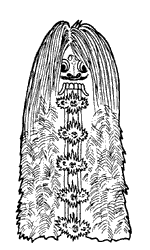 |
|
||||
| |
|||||
|
|
|
|
|
|
|
Literature Connections for
|
|
Native American Myths, Legends, Stories Archaeology and Exploring Your Roots
The annotations include quite a few books of Native American
myths. Many of these myths focus on explaining natural phenomena,
as do the myths created by students in Sessions 3 and 4. Others
provide a window into the culture of specific tribes or peoples.
Providing students with a sense of these differences is an important
step towards reducing the stereotypical misrepresentation of a
uniform Native American culture. There are several books that
present other aspects of Native American cultural issues. They
range from a description of the structure and uses of tipis, a
collection of poems and songs by Native Americans celebrating
the relationship between earth and all creatures, to an account
of the uprooting of Native American life told by a young Navajo
girl. These are important in that they provide rich detail of
past and current Native American peoples, their values and their
struggles. One of the unit’s Going Further activities involves students
gathering oral histories of their families. Several books have
to do with exploring one’s own roots, from tracing family
records to historical research. The lists have been broken in to three categories, accessible via the links below: Native American Myths, Legends, Stories Archaeology and Exploring Your Roots
|
|
